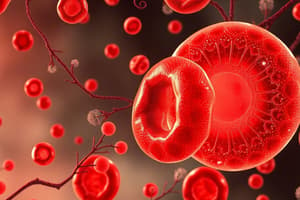Podcast
Questions and Answers
What is the main function of erythrocytes in the blood?
What is the main function of erythrocytes in the blood?
- Carrying oxygen to all parts of the body (correct)
- Transporting nutrients to all parts of the body
- Regulating body temperature
- Producing antibodies for the immune system
Which type of leukocytes are granulocytes?
Which type of leukocytes are granulocytes?
- Neutrophils and eosinophils (correct)
- Neutrophils and monocytes
- Monocytes and lymphocytes
- Basophiles and lymphocytes
What is the main function of basophils among the granulocytes?
What is the main function of basophils among the granulocytes?
- Associated with allergic reactions
- Involved in inflammatory responses (correct)
- Generating immune responses
- Protecting the body against infecting agents
Which formed element in blood is responsible for clotting?
Which formed element in blood is responsible for clotting?
What is the main function of lymphocytes among the agranulocytes?
What is the main function of lymphocytes among the agranulocytes?
What is the main function of platelets in the blood?
What is the main function of platelets in the blood?
Why is fibrinogen important in the blood plasma?
Why is fibrinogen important in the blood plasma?
Which statement correctly describes the difference between lymph and blood?
Which statement correctly describes the difference between lymph and blood?
Why is blood considered a connective tissue?
Why is blood considered a connective tissue?
What is the significance of double circulation in the circulatory system?
What is the significance of double circulation in the circulatory system?
Flashcards are hidden until you start studying
Study Notes
Blood Components and Functions
- Erythrocytes (Red Blood Cells): most abundant cells, contain haemoglobin, carry oxygen to all parts of the body, produced in bone marrow, 4-6 million RBCs per cubic millimeter of blood.
- Leukocytes (White Blood Cells):
- Granulocytes:
- Neutrophils: phagocytic cells, protect against infecting agents
- Eosinophils: associated with allergic reactions
- Basophiles: involved in inflammatory responses
- Agranulocytes:
- Lymphocytes: generate immune responses against infecting agents
- Monocytes: phagocytic in nature
- Granulocytes:
- Platelets: small irregular bodies, promote clotting, contain essential chemicals that help in clotting
Plasma and Plasma Proteins
- Plasma: colorless fluid, transports food, CO2, waste products, and salts, constitutes 55% of blood
- Plasma proteins: 6.8% of plasma, consist of fibrinogens, globulins, and albumins
- Fibrinogen: synthesised by the liver, plays a role in blood clotting
- Globulin: major protein, protects the body against infecting agents
- Albumin: major protein, helps in maintaining fluid volume within the vascular space
Miscellaneous
- Blood as a Connective Tissue: considered a type of connective tissue due to its mesodermal origin and ability to connect body systems
- Lymph vs. Blood:
- Lymph: colorless fluid, lacks RBCs, contains plasma and fewer WBCs and platelets, helps in body defense, part of the immune system
- Blood: red-colored fluid, contains RBCs, associated with circulation of oxygen and carbon dioxide
- Double Circulation: process where blood passes twice through the heart during one complete cycle, found in amphibians, reptiles, birds, and mammals, more prominent in birds and mammals
Studying That Suits You
Use AI to generate personalized quizzes and flashcards to suit your learning preferences.



